Hiroshima Peace Memorial Museum
Hiroshima and the Peace Memorial Museum
Time to finally tell you in details about my trip to Hiroshima and visiting the Peace Memorial Museum that was built upon the place in the area where the A-bomb was dropped 71 years ago. I was as much as excited as the others who travelled with me and surely after leaving the Museum I had much to think about. We spent one day and night in Hiroshima before moving to another place. What I experienced and how I felt with other impressions of the city you are about to find out soon. Ready? Let's go!
The bus ride from Osaka to Hiroshima
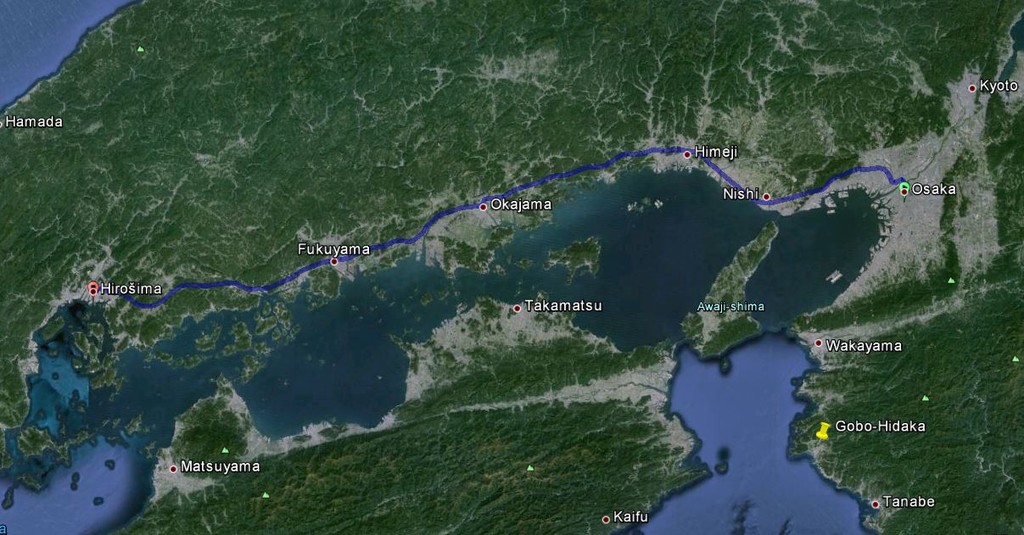
Trip to Hiroshima was on Day 19 of me being abroad. And it was on the 3rd day of the Youth camp. The trip took a bit more than 6 hours until we left again the bus in Hiroshima. But on our way there we stopped several times including having a lunch break (buffet) in Fukuyama. I used the Google Maps above to show the possible route. The distance between the two cities is about 330 kilometers and without making pauses should take about 4 and a half hours. Tokyo, for instance, is about 500 kilometers away from Osaka.
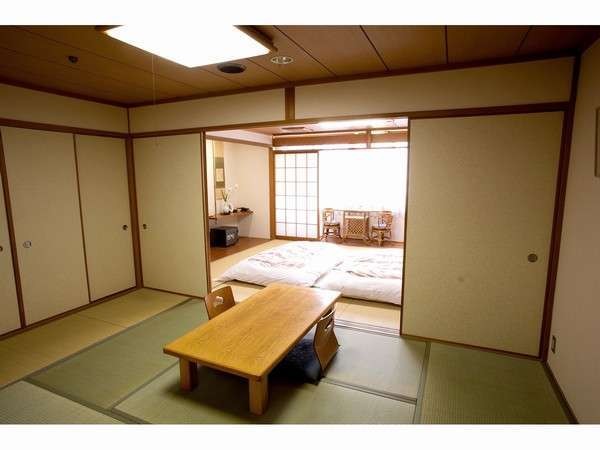
We slept in one hotel with sort of traditional rooms with mattresses on the floor (which were pretty comfortable and thick) and a bit uncomfortable narrow toilets which gave lots of troubles to all of us taller in the group when we had to sit there.
The night before we had a Bon dance festival organized at the same hotel and a social gathering.. but more of it later in a special article. Below you can see the view from our hotel bordering some neigbhourhood.
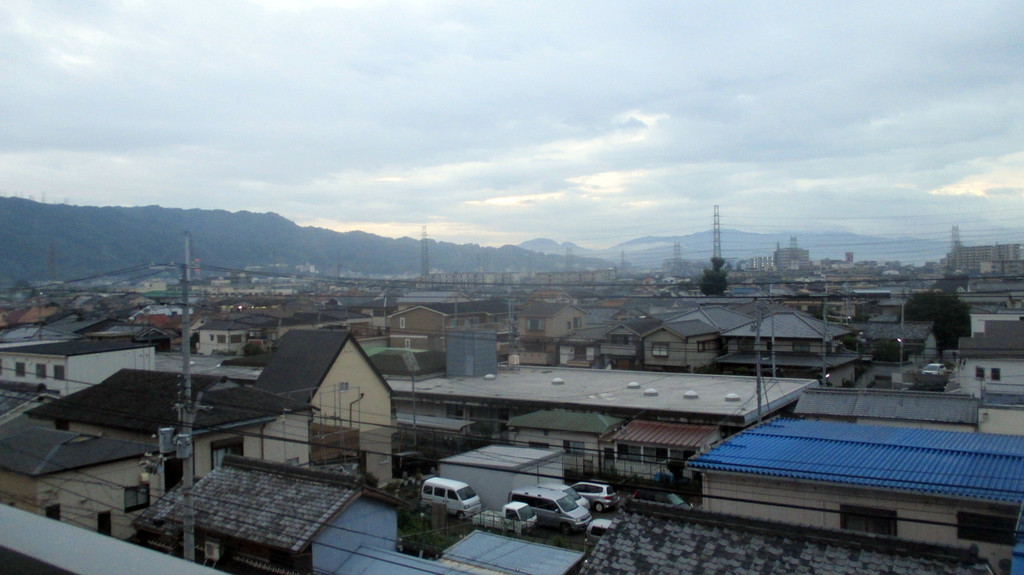
The look from the window at 5am. Back there I had no idea where we were in Osaka but the location of the Yao Grand Hotel might be here.
Anyway, we had to wake up at 5am, gather at the lobby room about 5. 30 and left the hotel at 5. 45. Everyone packed their stuff before going to sleep (almost everyone... ) in order to avoid the problems in the morning. We had a quick breakfast at the hotel... or in the bus, I cannot remember... I know I was among the first to take my seat in the empty bus so I could continue sleeping or hibernate, haha. Everyone got with their bags in time to the bus... well, almost everyone. There is always this one person who forgets something, panics, is always late and everyone is angry and confused because of delays.
On the road and stopping several times
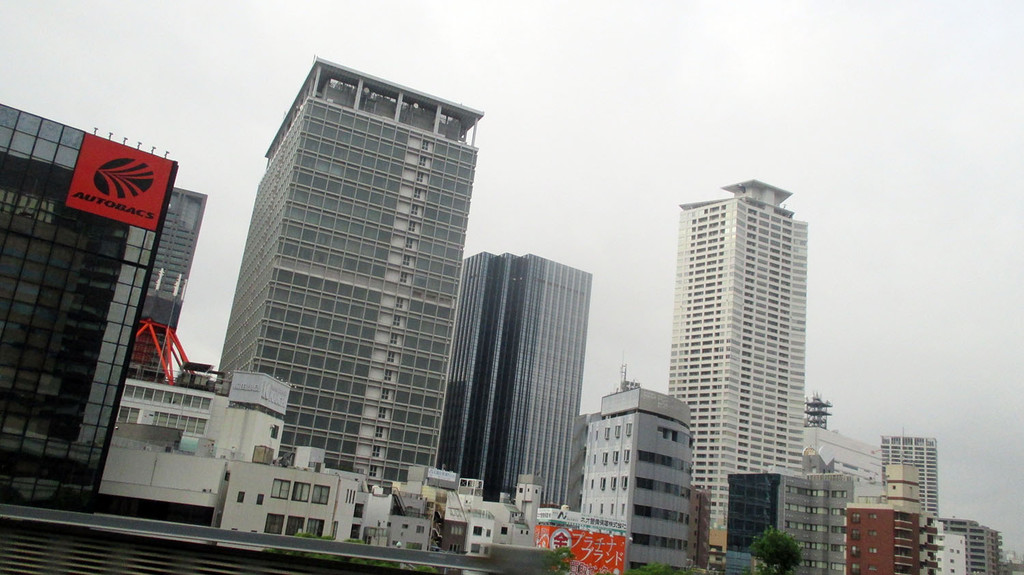
I remember leaving Osaka was again an amazing experience, just to look at the urban landscape and all the Skyscrapers. Though sometimes it seemed to me a bit cold, like a ghost town, and I would not like to live there. What do you think? Take a look at the photograph above taken from the bus on the high way through the city. (another topic to be discussed, be patient! )
Stopping at several resting-places by the high way and Starbucks
I am not sure how many times we stopped actually, about 3 before having lunch in Fukuyama, as the trip was pretty long. I could not sleep anymore once I woke up and I sat to one Mexican to get to know each other better. We soon became good friends and commented our experience so far of being in Japan. And of course - football. haha During the bus rides you get the opportunity to talk with other people and get to know each other better. So until Hiroshima I had changed my seat several more times to meet the other friends.
We stopped at some shops and stores within the resting-place by the high way with a break of 15 minutes. The bus was equipped with food and drink for everyone. Just noone wanted to drink the green tea. haha
During one pause at a bigger place (which also had an improvised market place haha) we went through the shops in a group checking what to take in the bus since our camp leaders and bosses told us they would pay us for the snack and other things. They were doing their best during all days of the camp to make us feel as comfortable as possible and I am very thankful for it. We also found some free candies and regardless of a taste took them while the opportunity lasted.
And the last one to mention is Starbucks. Now I remember it, we came to one Starbucks after leaving Osaka in order to have a first or second breakfast. They paid for us again there for the food. Personally, it was my first time to enter Starbucks and eat / drink something from it. I am not a fan of it and we do not have them in Croatia as this Western (or American? ) style of "grabbing coffee to go" is not what we do but rather sit for hours with friends surrounding us and chatting. Some of you who are reading the text right now and come from Croatia will understand perfectly what I am saying.
Lunch at Fukuyama
I do not remember anything interesting worth mentioning now for the rest of the trip. The landscape around us was full of hills and forests, sometimes we might have seen the sea (the ocean) but mostly hills, hills and hills. And when we were approaching some bigger city everyone started shouting "Hiroshima! Hiroshima? Are we there? " and then went back to our conversations. There was one popular game that was played by the guys in the last seats. Yes, you are right. "Popular - game - last seats" can mean only something stupid. haha There were numerous tunnels on the way and some came to an idea of holding your breath until we leave the tunnel again. It was supposed to mean we were diving.
Anyway, we came to Fukuyaman the second biggest city in Hiroshima prefecture with the population of about 465 000 citizens. We spent there an hour at one hotel having a lunch, the buffet. It was pretty delicious and i love the idea of being able to go around and pick up what I want. I tried to try as many thing as possible because it was really well prepared, tasty and... who knows when is going to be the next time to enjoy the good food without (almost) no end. :D
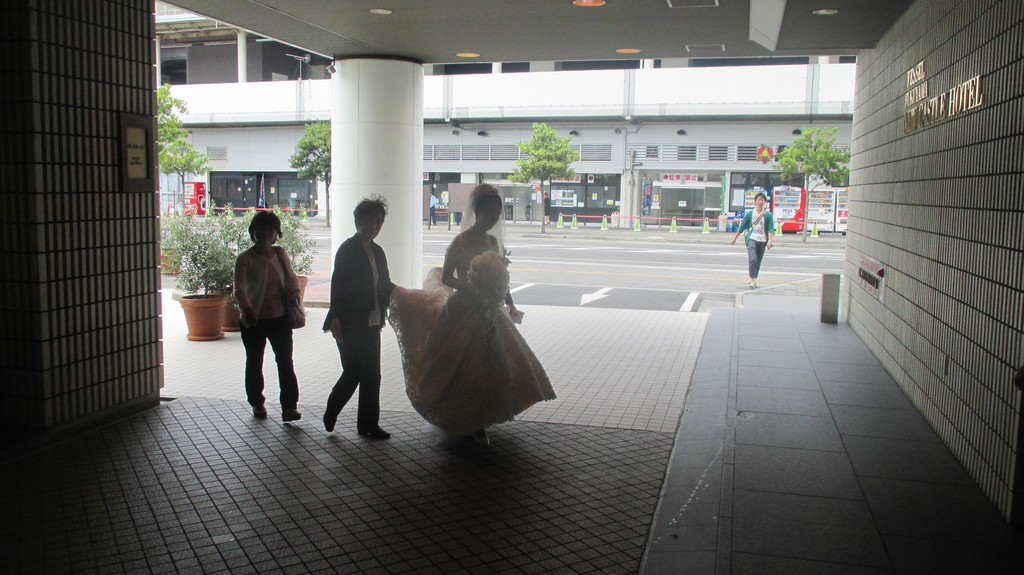
We also had a chance to witness a young couple preparing to get married so we clapped to them and cheered when they were passing by us and laughing. Great. Back in the bus. We had now about an hour until being in the center of Hiroshima.
Arriving to Hiroshima
After an hour we finally saw the signs with the name of our destination on them. Everyone was getting excited. I was getting my cameras, especially the analog one, ready to use as I could not miss the opportunity to document what I was seeing.
You can also image that everyone had this kind of jokes or silly questions whether there was still a desert after the World War 2 and if we were going to see the area without life. Of course not. I can tell you that one who visits Hiroshima without prior knowledge of the catastrophe during the World War II would have no idea what happened there and would notice nothing.

Hiroshima today is a pretty modern city full of life, almost completely renovated after the tragedy in 1945 and a nice place to live in. Hiroshima city is the largest city in Chugoku region and counts the population of a bit more than one million citizens. So it might be like the population of Vienna minus one from Zagreb.
The name of the city means "wide island" (hiro-shima) as the medieval Hiroshima was built upon the huge river delta and many islands. If you look at the map of Hiroshima you will notice that it still has at least 4-5 enormous islands between the western and eastern bank of the river Oota.
Another question that many asked me and some of you might be thinking of - is it not dangerous to live there or even visit the city because of radiation? The answer is - no. Hiroshima and Nagasaki are not the same case as Chernobyl. The atomic bomb killed thousands of citizens immediately and injured tens of thousands who died later because of the consequences of the explosion and radiation back then. Another difference is that the bombs exploded in the air whereas the nuclear reactor was leaking into the ground in Chernobyl. Thus both Japanese towns were able to be inhabited again relatively fast after the World War was over. The reactor in Chernobyl was 200-400 times stronger than the bombs in Hiroshima and Nagasaki together and still continues to leak into the ground making it uninhabitable for... a very very long period.
So basically, I did not come back from Japan with three eyes and six hands. It might be as to live there as in Zagreb or Vienna. As you can notice on the photograph above there are no mutants walking in the streets.
On our way to Hiroshima Peace Memorial Museum

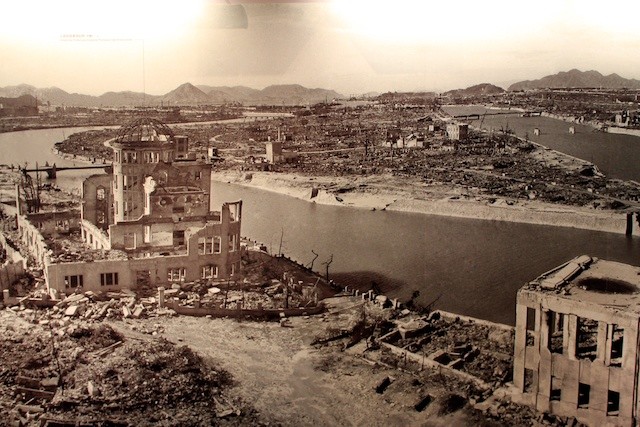
Hiroshima - where today meets the past. The upper image is mine.
I had no idea where we were in the town and everyone was waiting to see the landmarks of the city and one of the symbols of the destruction during the World War 2. And then while crossing one of numerous bridges we saw the infamous A-bomb dome which was left in the original condition as a memory of the great tragedy and catastrophe from the past and as a memory of all those who got killed. Everything you see on the photo above was turned into dust on August 6, 1945. Everything except for few buildings that survived, including the obvious example of the A-bomb dome.
This place on the island is really the heart of the city and just as they said during the WW2 that the plan was to drop the bomb right above the center of Hiroshima.
We left the bus on this island (in the corner of the northernmost point) and went across the bridge to pass by the A-bomb dome. I was the last in the row as I had to stop every few meters to make sure I document everything. And I am especially nervous with the analog camera. I am especially proud of the analog photographs from Japan as I was pretty lucky and got a nice number of photos that are going to remind me forever of the unreal experience in Japan. I might add as well there is the Hiroshima castle not far away from here but we did not know that nor it was on the list to visit it. If you happen to go to Hiroshima it might be useful to know.
A-bomb dome or Peace Memorial
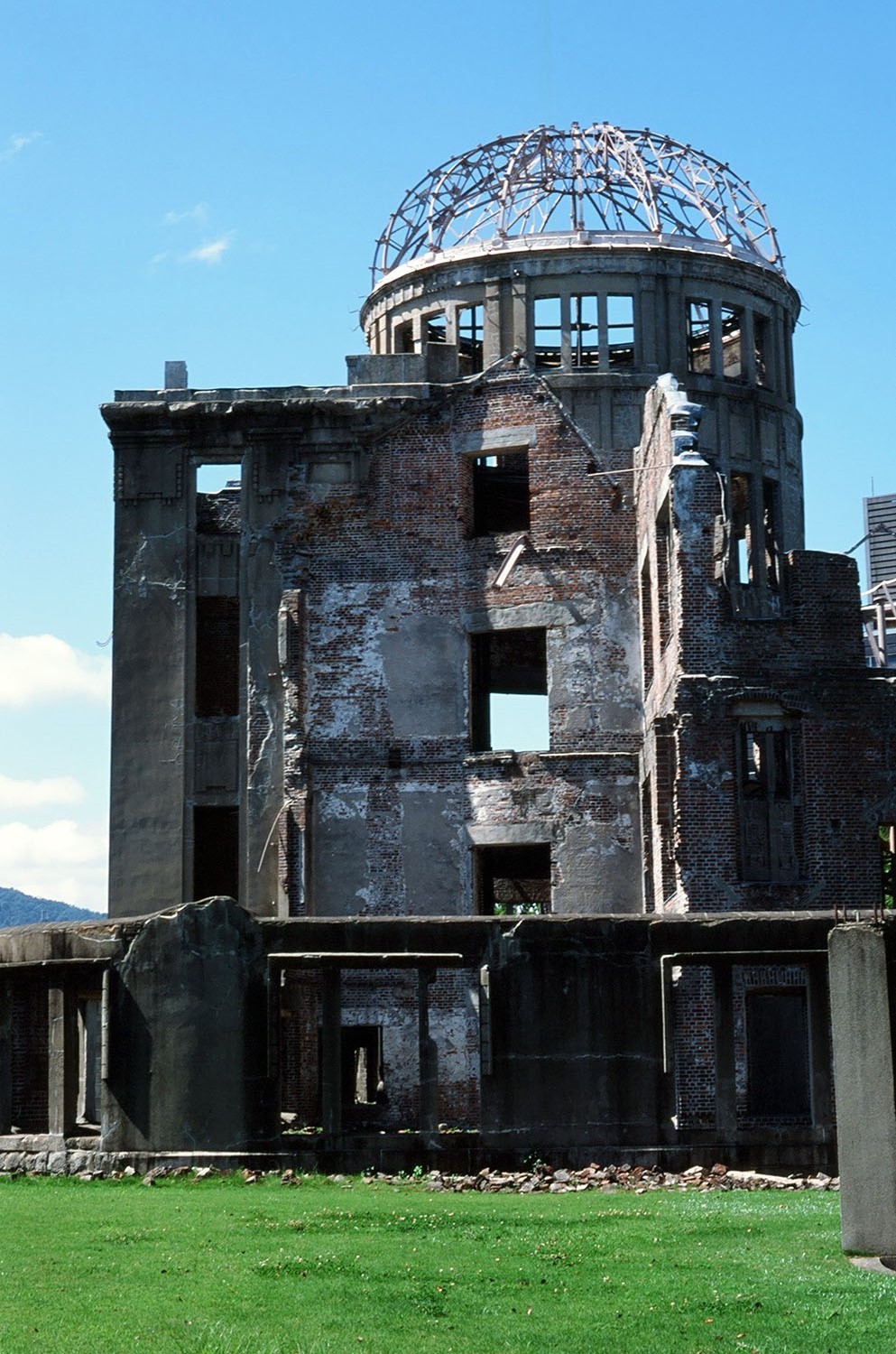
Above is the another shot of the A-bomb dome. It is also known as the Peace Memorial or Genbaku Dome in Japanese. The bomb exploded within the range of 500m of the dome. The story goes that the bomb missed a bit the desired target - the "T" bridge next to the dome. The one we just came across from the bus.
We headed now to the building which was enclosed and there were several monuments talking about this historical place and of the events that occurred. The stories were written at some places in English and other foreign languages.

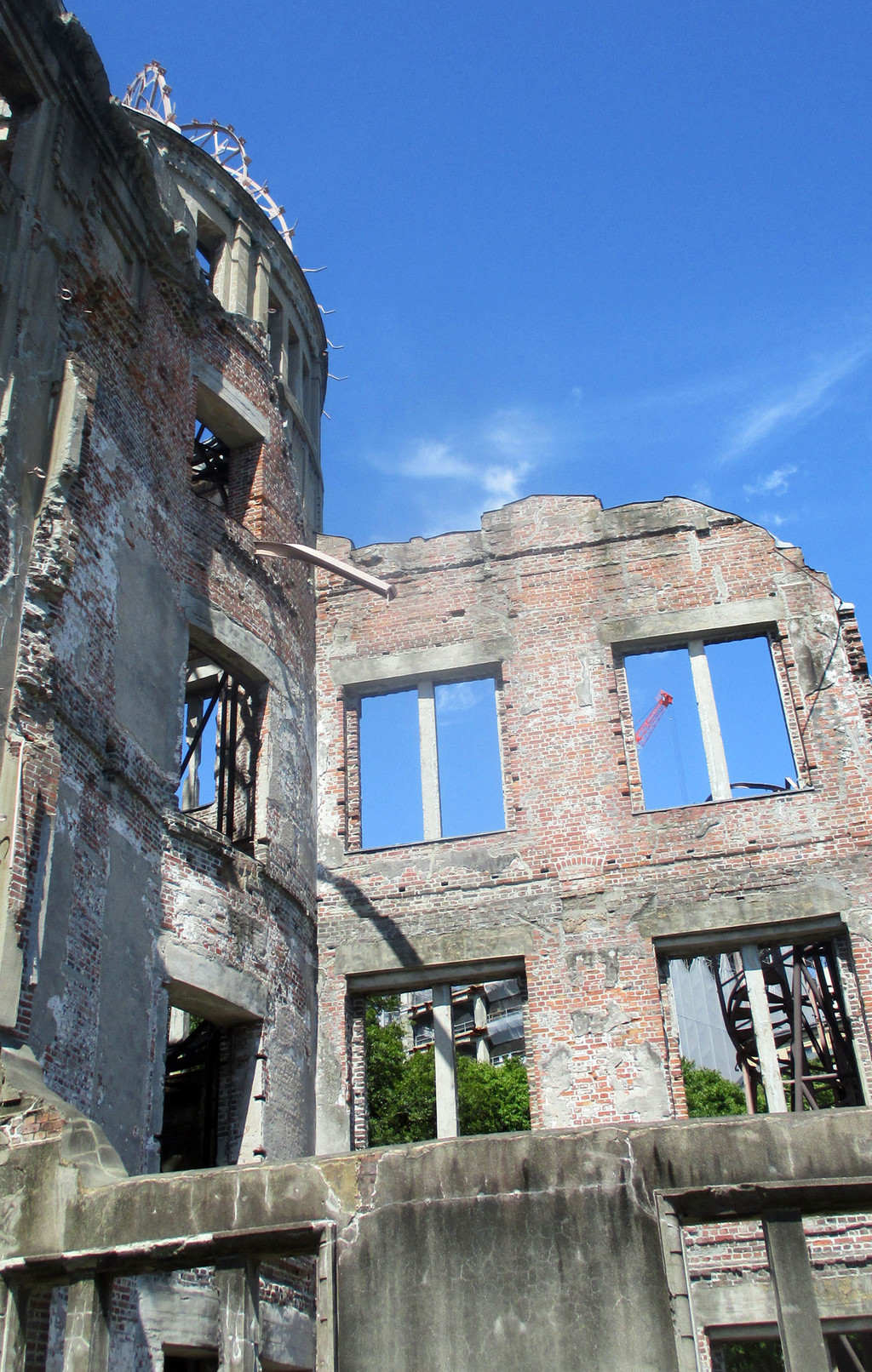
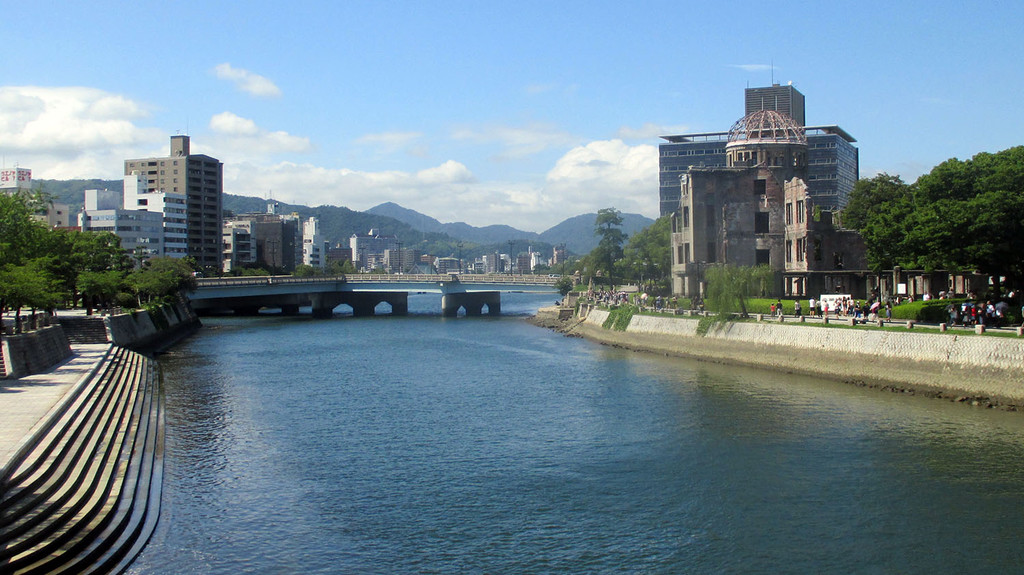
We continued walking further on until the next first bridge that would lead us back to the other side of the island with the Museum. The whole way down to the bridge is luckily through the park and you are covered by the trees and in the shadows as in summer it is not only hot but very humid as well in Japan.
Children's Peace Monument
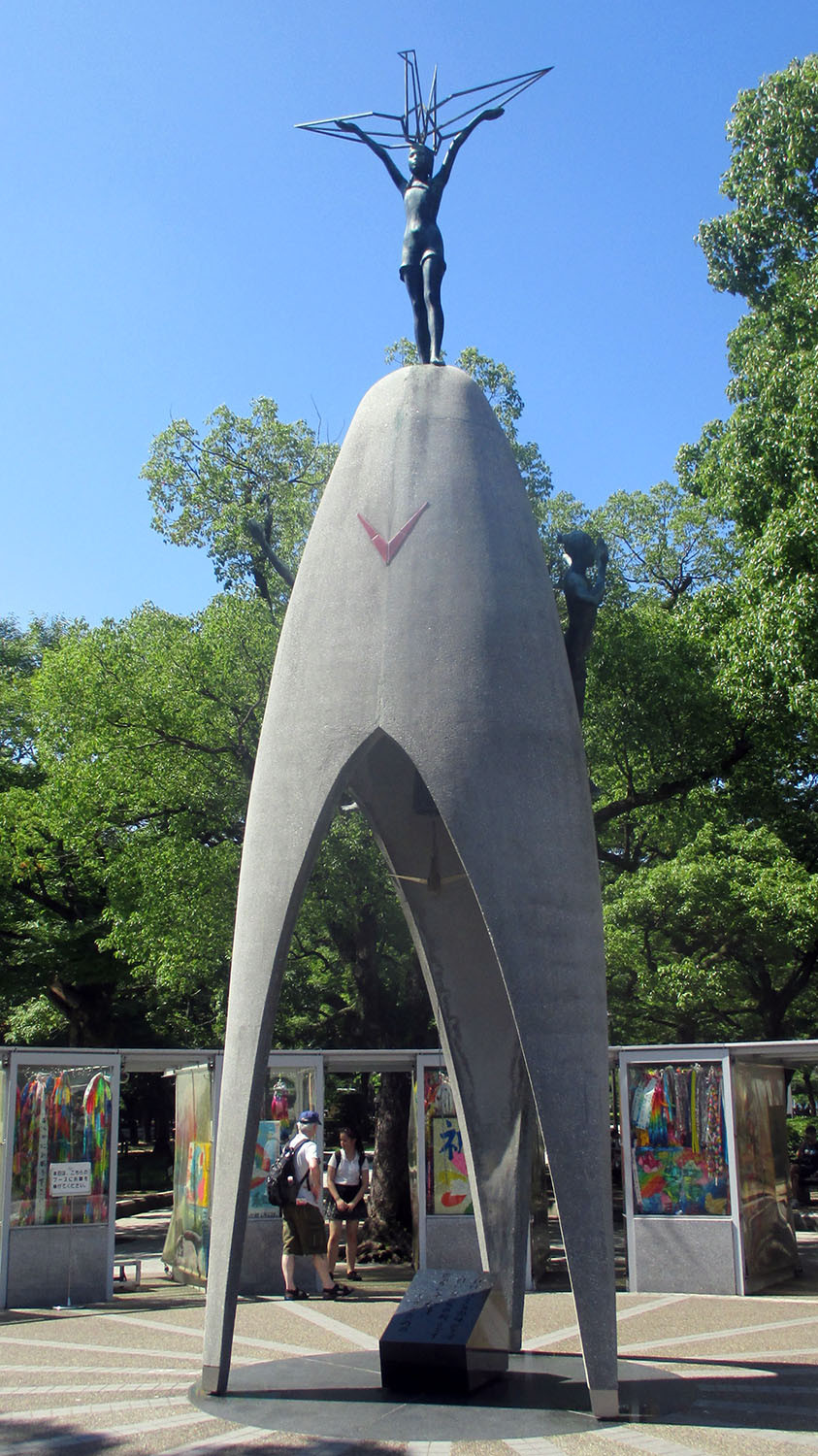
Right on the other side you will enter a little square which has a big monument in the center. At the top of this modern monument there is a statue of a child holding a huge origami crane. I think you might already know whom should this statue be representing. When I was there I did not get it at first as you just have to look at all the things and sometimes details. Of course, the statute represents young girl Sadako, one of the symbols of the struggle of post-war period.
The true story of Sadako Sasaki is known worldwide. I believe many of you had to read the book in the elementary school called "Sadako wants to live / The Day of the Bomb" (German: Sadako will leben) written by the Austrian author Karl Bruckner in 1961. The story is about the girl who suffered from radiation after surviving the atomic explosion in 1945 and believed if she could fold 1 000 origami cranes her wish to get cured would be fulfilled. However, Sadako eventually died at the age of 12 as her health started worsening and not being able to finish one thousand cranes. She died from leukemia. Sadako and her story of struggling to survive and have a normal life are one of the symbols of the innocent victims of the war. The story is being read in schools worldwide to encourage the peace in education. I will return back to Sadako once describing the experience in the Museum.
Around the monument dedicated to the innocent children you will notice closed display cases or vitrine with thousands of folded cranes. There are several of these vitrines you could go around containing hundreds and hundreds of the colorful origami cranes. They were being folded by the children worldwide who then sent them here in honor and respect to the children died as a result of the atomic bombing.
We also delivered one huge pile of the folded cranes made by the camp participants. On the first day of the camp (which I missed... explain later) there were organized a workshop and a competition in making of the cranes. The goal was to make as many as possible. As I heard from my friends they had no idea what it was planned to be used for and they thought it was just part of the fun. But now everyone was proud and happy to be part of this and I can say that they really did a lot of work.
Peace Memorial Museum
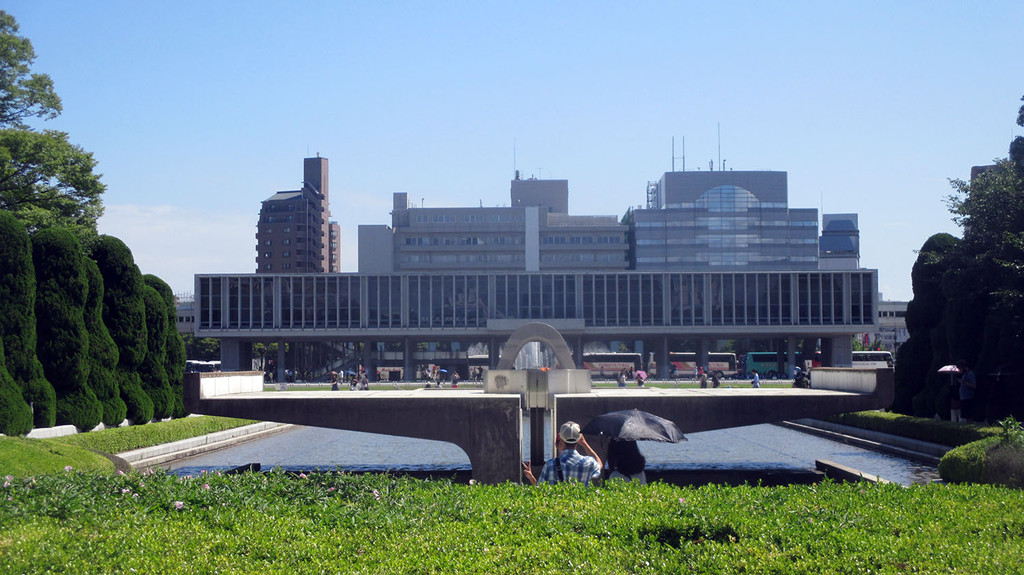
After crossing a small car road we enter the Heiwaikinen Park. In front of your eyes you will have.. well, a view like the one up on the photo. There is a whole constructed area opened in 1954 by the architect Kenzou Tange.
The first thing you see up there is the monument called the Peace flame (there is a little flame burning if you look carefully! ) whose flame has been burning since 1964 and will not stop burning until all the nuclear weapon in the world is out of use and there is no more potential threat to the planet Earth and catastrophes like the one that hit Japan in 1945.
The whole area is relatively big and open with the Pond of Peace in the middle about 100 meters long. Once we passed by it there were three paths leading us to the big building behind - the Peace Memorial Museum. That pathway was also about 100 meters long and full of greenery and flowers by the side.
At the end of the pond there is another monument - the Memorial Cenatoph. It was raised in honor of thousands of Koreans who died during the Hiroshima and Nagasaki bombing as they were brought there as a labour power during the Japanese colonialism. The information reveal about 45, 000 Koreans died during the bombing, which makes about 1/10th of the total number of victims in these two cities.
We came under the building which is lying on many strong columns and found the entrance by walking upstairs. I was really curious to start viewing the exhibition and did not know quite well what to expect. One thing was sure - once you go throughout the exhibition and try to fly back to August 6 in 1945 you will most likely have your mindset changed.
The tour around the Museum
At the beginning we all gathered up and made a deal to wait for each other in an hour or so right behind the exit of the Museum. We also got the audio devices provided in several languages. I took the one in English of course. And then they let us in. We climbed a bit upstairs and then entered the room.
The first thing I actually remember now when writing this and in general when someone mentions the Memorial Museum is the scene and simulation of one corner of the room in the real size proportions with 2-3 persons about a meter and a half tall, maybe children and a mother, burning in flames, having faces almost unrecognizable and with their skin being ripped off and merging with the blood, gluing to the clothes and falling apart from the hands and the head. The scene was pretty realistic with ruins and black shadows everywhere and the dolls representing the victims who survived the slaughter had a striking impact on the viewers. Though I had my camera ready to take the picture I felt terribly sad, anxious and a bit nervous when looking at the scene in front of me. I decided not to take the photographs of such sceneries. But I will put the photo here though, it cannot transfer the same feeling and emotions as standing there and with the effects of dropping and moving. The image credits go to the author.
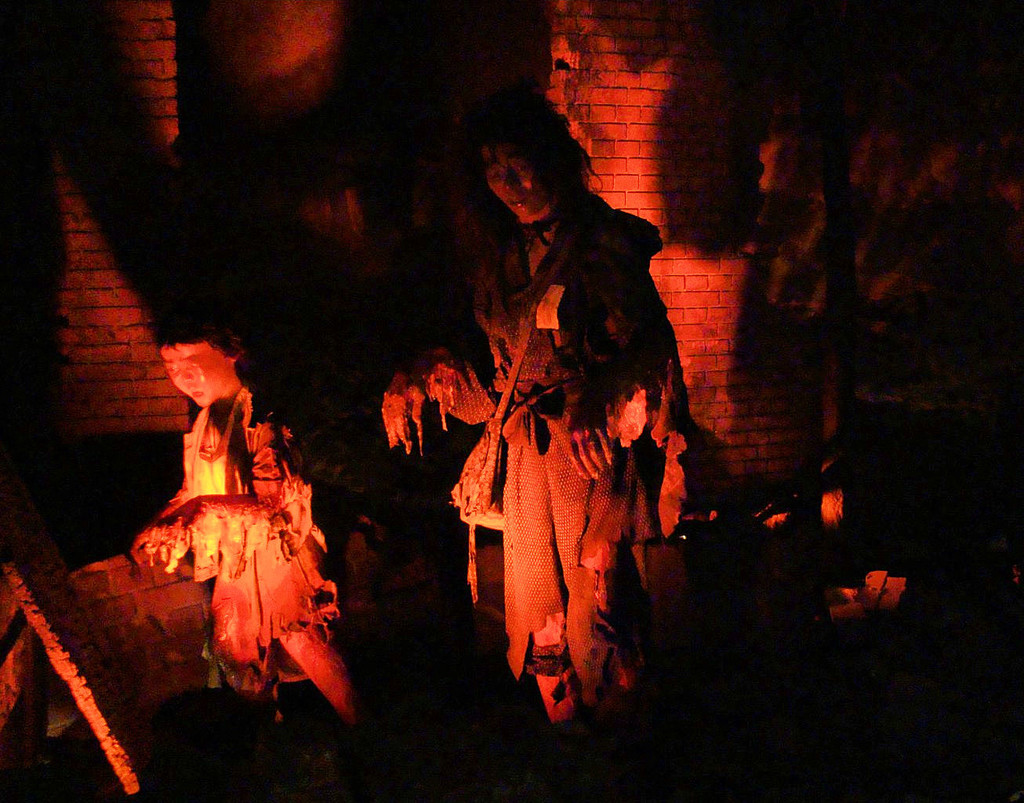
I do not remember anymore precisely the order of the exhibitions within ca 2-3 bigger halls but I remember several stuff that always come to my mind when mentioning it.
The fate of Hiroshima in 1945
As we got a nice book printed in the Museum as a present for us and a memory from the Youth Camp in Japan from our Lions Clubs I waited to go back to Croatia and then read the whole book (with the photographs and stories exhibited in the museum) while resting in Dalmatia in peace. I might not have been so much interested (or like an average person) into bombing of Hiroshima but after visiting Japan, the Museum and having now a special kind of a relationship to this country and its people I became really curious and wanted to know more.
There were a few things that I had not known before that I would like to share.
- Which other places where potential candidates for the a-bomb?
There were several cities as the potential candidates. These were Hiroshima, Kokura, Niigata and Nagasaki. One would ask why Tokyo or Kyoto were not going to be eliminated since they were sort of cultural and historic capitals. Because the royal family with the Emperor resided both in Kyoto (an ancient city) and in Tokyo killing them would have a negative impact on the population which would likely refuse to cooperate with the Allies during the occupation of Japan. Also, they wanted to demonstrate the power of weapons in order to fasten up the surrender of Japanese forces.
- Why was Hiroshima chosen?
According to the reports the Allies wanted to drop one bomb as soon as possible on one of the 4 cities. And the final decision was dependent on the weather. The day before dropping the bomb the pilots were flying around the target areas in order to collect the weather forecast information. They found out that on the next day, on 6th of August, the sky was going to be clear above Hiroshima. It was in this moment that the fate of the city was sealed.
- The citizens of Hiroshima could have been warned?
Apparently there was a discussion among the Allies and the scientists whether the local population should be warned before the attack to hide as no one knew the consequences of this type of a bomb. There were letters to the president claiming Hiroshima should be warned. In the end they decided to test the bomb on the city without prior warning. The bomb exploded at 8. 15am local time.
- Other consequences of the bombing?
After the great flame and destruction of the majority of the city there was another problem that brought misery and danger to Hiroshima. It was not just radiation. After the huge mushroom smoke and the smoke of the fire soon gathered black clouds and the black poisonous rain started making the life in the whole area both dangerous for the humans, the animals and the greenery.
- What was the number of people who died and the radius of destruction?
I would use this to compare it with possible situation in my home town, Zagreb. There are many estimations of the number of dead but the number of those who died in 1945 might be around 70 000 people (and those who died because of the effect of radiation and other injuries grows then in total to about 14 000 some say). Hiroshima had then the population of a 310 000 citizens so this was erasing almost a half of the population in the end.
Everything within the radius of 1 mile (1. 6 km) was destroyed completely and the rest within 3 miles (almost 5 km) was heavily damaged or destroyed. When I apply it to the distances in Zagreb it seems that while drinking a coffee at Tkalča Street I would disappear along with my colleagues haha into the next dimension in less than a second if the hypocenter of the explosion was at the Student center next to Cibona Tower. I would be close to escaping the fire and death if the bomb exploded above the main square ban Jelačić and I was riding a bike on the western side of Jarun lake. It is still strange to think that within a blink of an eye everything could vanish. And that was the power of the nuclear weapon 70 years ago...
Using the audio device and headphones
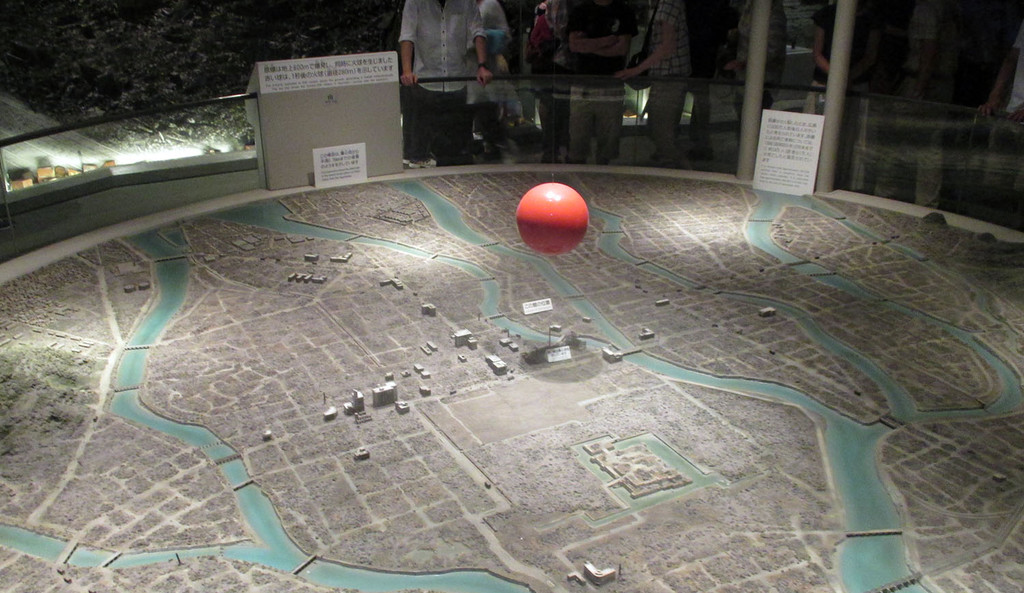
I forgot to add that each of the exhibited objects had a number next to each other so you could type it in on your audio device to listen to the specific story of any item or event in front of you. I tried to listen to every story behind the exhibits as I found them interesting.
What I really liked and found to be very effective (if it had to affect the audience) was that the voice was often reading from the records, sometimes the diaries or the reports from the hospital or a family if it was about the members who lost their lives. It made you feel like you were there or like it happened recently and you are now listening to the detailed reports.
A few times the stories of the horrors of the way people vanished or died suffering from injuries and radiation were literally so ugly and sick to hear that I was forced to take off the headphones or stop the device as I could not listen to it anymore. I visualized the images of the what I heard instantly in my head and it made me feel sick. Huh, right now I just remembered one horrifying and disgusting story about... well, I am not going to share it with you.
Sometimes the stories I listened to about the persons who survived had a promising ending.. but then in the last few sentences the person's health worsened and they died with terrible inner disorders, tumours etc. All of that could make you only feel pessimistic.

Another story I remember is related to a 3-4 years old boy who went that morning out on his little tricycle. Both he and the vehicle were caught in flames and suffered burning heavily. The boy died the same evening later and his family decided to burry him with his favorite toy together. About forty years later the father dug up the remains of the tricycle and gave it to the museum. Photo credits to the author.
And there are many more like this. I saw many destroyed school uniforms which survived the deadly blast but they owners were obliterated within a second into the dust. Among the school uniforms there were several lunch boxes and even the content was kind of fossilized. There was another story of the children who died immediately as they were called to prepare the anti-aviation spots and thus found themselves exposed on the open when the bomb was dropped turning them into the dust.
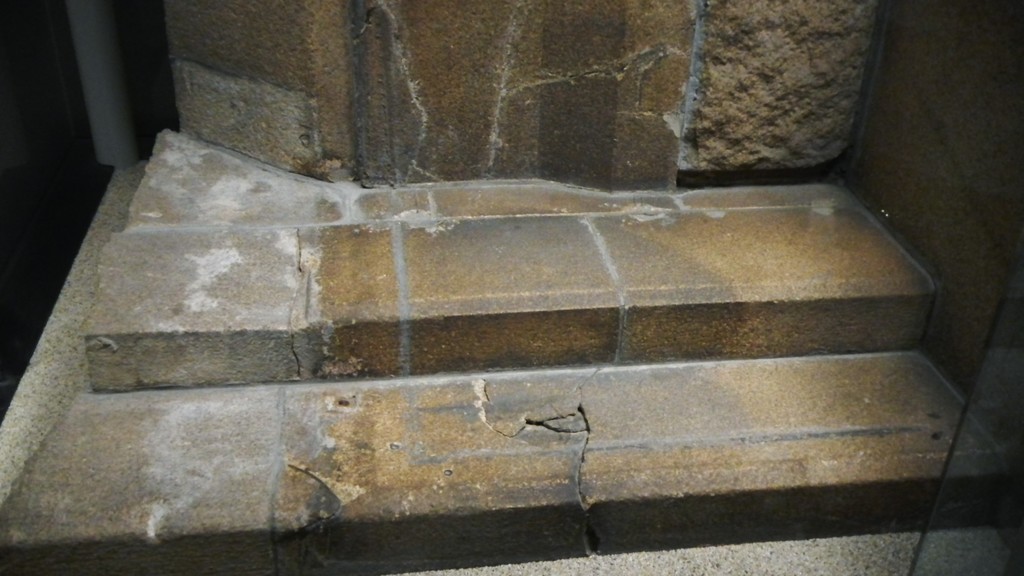
One more story that gives you goosebumps was related to the stone of the entrance of the Sumitomo bank. At first looks boring as according to the story and what we saw everything turned white after the explosion. Except for the one darker path. It is believed that there was a man sitting on the stairs and waiting for the bank to be opened. He or she was sitting about 250 meters from the hypocenter when the bomb exploded. The person perished from this world within the blink of the eye. The only leftover of the existence was the shadow that remained. Photo credit to the author.
And because the a-bomb was so powerful it even left shadows "fossilized" on the floor or the buildings. There are also plenty of huge photographs documenting the situation in the city and demonstrating this phenomenon. And there were many photographs of the human bodies which survived the explosion but suffered from great disorders. I will not publish these photographs as well as those of the human body parts that mutated and brought terrible pain to their owners.
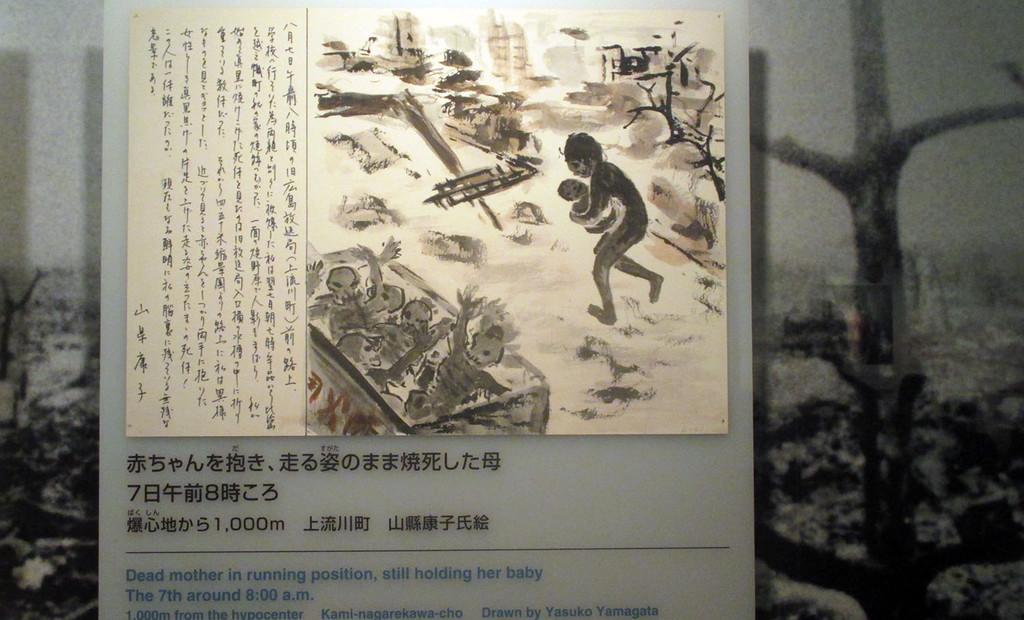
Personally, after listening, seeing and reading everything there I think it would be much better to disappear without even knowing it rather then suffer from such injuries.

One more interesting thing to see was the exhibition of all the objects and artifacts that survived the blast and the fire but were totally distorted. On the picture you can see the distorted roof tiles that seemed to be like modeling clay for children. We were also allowed to touch some of these objects and it was really weird. It was a connection with the past. 71 years earlier and I would be turned in the the dust and the whole area into a hell on the Earth.
Honestly, there are so many things to tell about regarding the Museum and the event that it would be the best to take some book hehe and read about it. I still have to mention a few things that remained in my memory.
They also had, as you saw above, a room with a huge model of Hiroshima and the place where was the hypocenter of the a-bomb. There were many infographic though I think some more could have been added. In other room there was a replica of 'Little boy' and the infographic explaining the structure of the bomb and its effect.
The museum was full of visitors and there were many people from the Western part of the world.
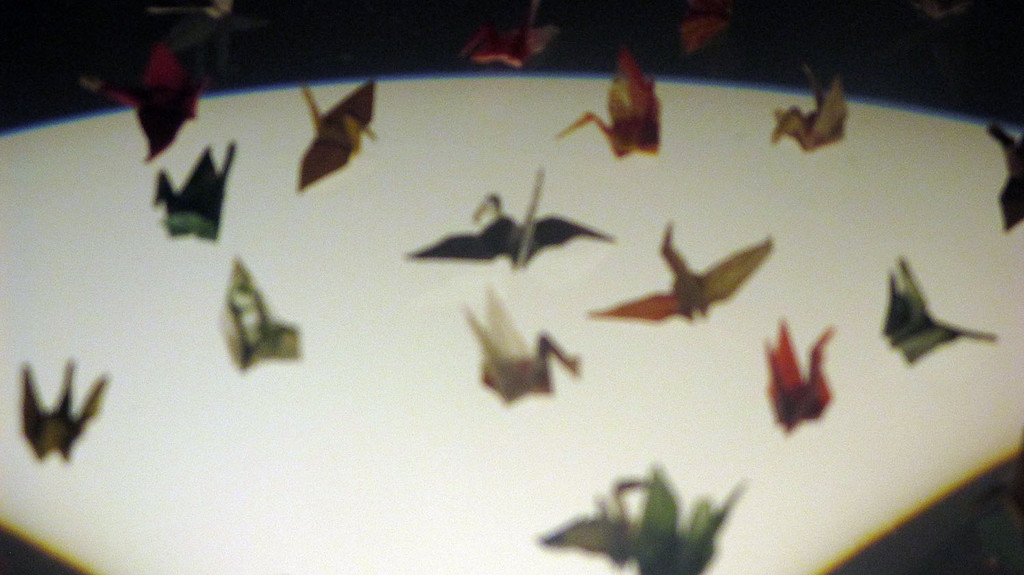
Alright, the last thing worth mentioning was the part of the room dedicated to Sadako Sasaki. There you can find her personal diaries, toys and her cranes exhibited in an enclosed glass. Unfortunately, when I was taking a photo of it I did not realize there in the darkness it was not sharp, my apologies (I hate Android camera, I really do! ). I always used to imagine those cranes from the story and the book to be much bigger. But those you can see on the picture are almost of that size in real life, not more than 3-4 or max 5 centimeters long.
The interviews with the survivors
The last thing before leaving back to the bus was the room with lots of screens where one could choose to watch specific person having a talk about the experience in 1945. There was a heavy printed book with the list of all the survivals and those who died and were recorded. At first I did not want to pay any more attention to anything regarding the bombing but then the interview just got my attention.
We spent 20 more minuets watching several survivors telling us their stories. There were subtitles in English and other languages. Each of the stories is pretty unique and luckily all those who survived suffered from no illness except for being followed by the horriyfing scenery from their childhood.
I remember only two stories of one seniors who survived the blast with a few of his friends back in the school and another one in her own house. He said he was going to the lower classes of the elementary school and that it was a beautiful morning on August 6 with a clear sky. He was in the classroom. His friend and he were staring through the window and remembering hearing the noise of the Allies' airplanes for the last day. They heard one stronger noise that morning too but thought it was the normal thing. The last he remembers was seeing a fireball in the air and.... waking up later in the ruins. He was lucky to fall below wall and tables thus escaping the majority of the blast and surviving the explosion. He found out later that out of 25-30 children only a few survived.
Another woman said she was with someone else in the basement of their family house looking for something when they heard the blast. The upper part of the house and someone who was inside vanished. The basement saved her life.
In conclusion, this museum is really worth a visit! I hope I would have a chance to go once more there but if it happens it will be probably within one of the following decades, hopefully by the end of the 21st century haha. I do not believe there are people who went through the museum and were then totally neuter or not interested at all. The museum is very popular and visited every day. Also, in front of it behind the Peace pond there is every year on 6th August at 8. 15am a Peace Ceremony which gathers thousands of people on that island and park. The Japanese are today strictly against the war or any kind of violence in the world and I never noticed that someone hated for example the Western, especially the US. Some thing happened in the past but they learned how to change themselves and live normally in the presence. I think I cannot say the same for my country unfortunately.
Night at the hotel, discussion about peace and country presentations

Once we all gathered up and felt a bit depressed, neutral and strange we headed to the bus which was waiting for us in front of the building. On my way to the exit I saw the table with some stamps and guestbook where I signed myself and put the stamp on the flyer-guide of the museum. There was also an enormous book or a few of them where you could sign you were against the use of nuclear weapon in the world. I do not remember whether I signed this (probably yes) as I was the last one in the group again and rushed to catch the others.
We arrived to the new hotel which looked pretty big and surrounded with the skyscrapers. This was my second hotel with the camp and pretty different from the one we spent night in Osaka. Here we got our own rooms which I liked a lot. The room was pretty cosy and I had a relatively nice view over the urban landscape, over the other buildings and skyscrapers. Maybe typical Japanese for the big cities! I took there all the free stuff for the guest I was able to and then put some photos online. The room I spent a night in had its own bathroom and the toilet and a table. The bed was really comfortable with several pillows and a very good mattress. I even got the white "kimono" pajama which I decided to take to sleep in. Because why not?
After the dinner on the first floor which again included a buffet and was pretty delicious we had then a meeting in one bigger room and were split into several groups regarding colours (I was the pink! ) and were given 10 minutes to prepare the answers on three questions. These were regarding the peace in the world, personal opinion, what to do, what do we think of wars and the use of nuclear weapon and so on. I did not want to be the "speaker" of the group so we forced our Czech friend to be the one.
After the short discussion and lots of laugh we held then for less than an hour or so country presentation event. Several friends were showing their presentations of their home on the display. Some of them even wore the national clothing and offered us with some sweets or presents such as the souvenirs. I always enjoy listening to the others and learning something new. My turn was in 2 days when we were back in Osaka. But more about it soon.
The next day we went to visit one amazing place near Hiroshima and in the afternoon back to Osaka.
Thanks for reading!
Photo gallery
Content available in other languages
- Italiano: Hiroshima e il Museo della Pace
- Español: Hiroshima y el Museo Memorial de la Paz
- Français: Hiroshima et le musée du mémorial de la paix
Rate and comment about this place!
Do you know Hiroshima Peace Memorial Museum? Share your opinion about this place.












































